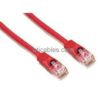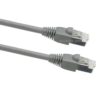Cat 5e Cables
Best Sellers
-
 Cat 5e Cables / Cross-Over Cat 5e 350MHz RJ45 Network Cable / Network Cabling
Cat 5e Cables / Cross-Over Cat 5e 350MHz RJ45 Network Cable / Network CablingCross-Over Cat 5e 350MHz RJ45 Network Cable, Red
From: $1.50 This product has multiple variants. The options may be chosen on the product page -
 Cat 5e 350MHz Shielded RJ45 Network Cable / Cat 5e Cables / Network Cabling
Cat 5e 350MHz Shielded RJ45 Network Cable / Cat 5e Cables / Network CablingCat 5e 350MHz Shielded RJ45 Network Cable, Grey
From: $2.10 This product has multiple variants. The options may be chosen on the product page -
 Cat 5e 350MHz RJ45 Network Cable / Cat 5e 350MHz RJ45 Network Cable - Blue / Cat 5e Cables / Network Cabling
Cat 5e 350MHz RJ45 Network Cable / Cat 5e 350MHz RJ45 Network Cable - Blue / Cat 5e Cables / Network CablingCat 5e 350MHz RJ45 Network Cable – Blue
From: $0.93 This product has multiple variants. The options may be chosen on the product page
-
 Cat 5e 350MHz RJ45 Network Cable / Cat 5e 350MHz RJ45 Network Cable - Black / Cat 5e Cables / Network Cabling
Cat 5e 350MHz RJ45 Network Cable / Cat 5e 350MHz RJ45 Network Cable - Black / Cat 5e Cables / Network CablingCat 5e 350MHz RJ45 Network Cable – Black
From: $0.93 This product has multiple variants. The options may be chosen on the product page -
 Cat 5e 350MHz RJ45 Network Cable / Cat 5e 350MHz RJ45 Network Cable - Green / Cat 5e Cables / Network Cabling
Cat 5e 350MHz RJ45 Network Cable / Cat 5e 350MHz RJ45 Network Cable - Green / Cat 5e Cables / Network CablingCat 5e 350MHz RJ45 Network Cable – Green
From: $0.93 This product has multiple variants. The options may be chosen on the product page -
 Cat 5e 350MHz RJ45 Network Cable / Cat 5e 350MHz RJ45 Network Cable - Grey / Cat 5e Cables / Network Cabling
Cat 5e 350MHz RJ45 Network Cable / Cat 5e 350MHz RJ45 Network Cable - Grey / Cat 5e Cables / Network CablingCat 5e 350MHz RJ45 Network Cable – Grey
From: $0.93 This product has multiple variants. The options may be chosen on the product page
-
 Cat 5e 350MHz RJ45 Network Cable / Cat 5e 350MHz RJ45 Network Cable - Orange / Cat 5e Cables / Network Cabling
Cat 5e 350MHz RJ45 Network Cable / Cat 5e 350MHz RJ45 Network Cable - Orange / Cat 5e Cables / Network CablingCat 5e 350MHz RJ45 Network Cable – Orange
From: $0.93 This product has multiple variants. The options may be chosen on the product page -
 Cat 5e 350MHz RJ45 Network Cable / Cat 5e 350MHz RJ45 Network Cable - Purple / Cat 5e Cables / Network Cabling
Cat 5e 350MHz RJ45 Network Cable / Cat 5e 350MHz RJ45 Network Cable - Purple / Cat 5e Cables / Network CablingCat 5e 350MHz RJ45 Network Cable – Purple
From: $0.93 This product has multiple variants. The options may be chosen on the product page
Top rated in this category
-
 Cat 5e 350MHz Shielded RJ45 Network Cable / Cat 5e Cables / Network Cabling
Cat 5e 350MHz Shielded RJ45 Network Cable / Cat 5e Cables / Network CablingCat 5e 350MHz Shielded RJ45 Network Cable, Grey
From: $2.10 This product has multiple variants. The options may be chosen on the product page -
 Cat 5e Cables / Cross-Over Cat 5e 350MHz RJ45 Network Cable / Network Cabling
Cat 5e Cables / Cross-Over Cat 5e 350MHz RJ45 Network Cable / Network CablingCross-Over Cat 5e 350MHz RJ45 Network Cable, Red
From: $1.50 This product has multiple variants. The options may be chosen on the product page
Information about Cat 5e and Cat 6 Patch Cables: |
|||||||||||||||||||||||||||||||||||||||||||||||||||||||||||||||||||||||||||||||
| The need for more bandwidth and faster networks forced a new standard in Category cabling in the late 90's. The Category 5 standard was ratified and the new cable standard became 100MHz at 100Mbps. Cat 5 was short lived once Category 5 Enhanced (or Cat 5e) came along. Cat 5e patch cables are tested up to 350MHz at 1 Gbps. Compared with Cat 5 and Cat 5e, Cat 6 features more stringent specifications for crosstalk and system noise. Like most earlier twisted-pair cable, Category 6 cable contains four twisted wire pairs. Attenuation, near end crosstalk (NEXT), and PSNEXT (power sum NEXT) in Cat 6 cable and connectors are all significantly lower than Cat 5 or Cat 5e.
Category 5e cable, commonly known as Cat 5e, is an unshielded twisted pair type cable designed for high signal integrity. The actual standard defines specific electrical properties of the wire, but it is most commonly known as being rated for its Ethernet capability of 100 Mbit/s. Its specific standard designation is EIA/TIA-568. Cat 5 cable typically has three twists per inch of each twisted pair of 24 gauge copper wires within the cable. The twisting of the cable reduces electrical interference and crosstalk. Another important characteristic is that the wires are insulated with a plastic (FEP) that has low dispersion, that is, the dielectric constant of the plastic does not depend greatly on frequency. Special attention also has to be paid to minimizing impedance mismatches at connection points. Cat 5e cables are often used in structured cabling for computer networks such as Fast Ethernet, although they are also used to carry many other signals such as basic voice services, token ring, and ATM (at up to 155 Mbit/s, over short distances). Cat 5e cable is an enhanced version of Cat 5 for use with 1000BASE-T (gigabit) networks, or for long-distance 100 Base-T links (350 m, compared with 100 m for Cat 5). It must meet the EIA/TIA 568A-5 specification. Virtually all cables sold as Cat 5 are actually Cat 5e. The markings on the cable itself reveal the exact type. ATI Cables offers the best prices on Cat 5e and Cat 6 cables in Canada. ATI Cables is the leading supplier of Cat 5e and Cat 6 network cables in Markham and Toronto. www.aticables.ca is known to sell the highest quality cables at the best prices to contractors and school boards who buy cables in Toronto, Markham, and Mississauga. How to Make a Category 5e / Cat 6 Patch Cable
Notes for wiring diagrams above:1. For patch cables, 568-B wiring is by far, the most common method. Patch Cable Assembly Instructions
Notes Regarding Making Cat 5e / Cat 6 Patch Cables1) The RJ-45 plugs are normally made for either solid conductors or stranded conductors. It is very important to be sure that the plug that you use matches the conductor type. It is extremely difficult to tell the difference between the two by looking at them. When you buy these plugs, be sure to categorize, and store them carefully. Using the wrong type can cause intermittent problems. 2) Ordinarily, it would be taboo to untwist the pairs of any category 5 cable. The one exception to this rule is when crimping on RJ-45 plugs. It would be impossible to insert the wires into the channels without first untwisting and straightening them. Be sure not to extend the un-twisting, past the skin point. If you do it properly, you will wind up with no more than 1/2" of untwisted conductors (up to 1/2" of untwist meets the cat 5 specification). 3) If the completed assembly does not pass continuity, you may have a problem in one, or both ends. First try giving each end another crimp. If that does not work, then carefully examine each end. Are the wires in the proper order? Do all of the wires fully extend to the end of the connector? Are all of the pins pushed down fully. Cut off the suspected bad connector, and re-terminate it. If you still have a problem, then repeat the process, this time giving more scrutiny to the end that was not replaced. 4) It is good to be prepared to make your own patch cables. There may be many instances where you may fall short on supply, and making a cable will surely get you out of a jam. However, there comes a point where the practicality curve will lead you to factory made cables. Making several cables can be very labor intense. Factory made cables typically have better tolerances, and consequently have better quality than field made cables. |
|||||||||||||||||||||||||||||||||||||||||||||||||||||||||||||||||||||||||||||||
ATI Cables is Canada's premier source of quality Cat 5e and Cat 6 Cables. Located in Markham, Ontario, ATI Cables supplies cables to Toronto, Mississauga, Quebec, Alberta, British Columbia, Manitoba, Saskatchewan, Nova Scotia, PEI, Newfoundland, and New Brunswick.


